Planet
Appearance

A Planet (from Ancient Greek ἀστὴρ πλανήτης(astēr planētēs), meaning "wandering star") is an astronomical object orbiting a star or stellar remnant that is massive enough to be rounded by its own gravity, is not massive enough to cause thermonuclear fusion, and has cleared its neighbouring region of planetesimals. The term planet is ancient, with ties to history, science, mythology, and religion. The planets were originally seen by many early cultures as divine, or as emissaries of deities. As scientific knowledge advanced, human perception of the planets changed, incorporating a number of disparate objects. In 2006, the International Astronomical Union (IAU) officially adopted a resolution defining planets within the Solar System. h
Quotes
[edit]- Quotes are arranged alphabetically by author
A - F
[edit]
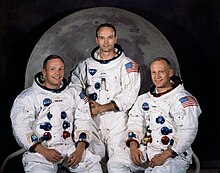
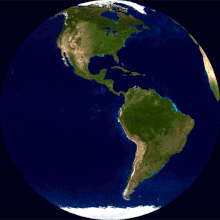
The sun revolving through th'eccliptic way
Effects the various seasons of the year,...
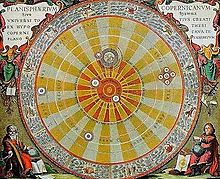
This oldest system, form'd a wiser scheme;
In which he leaves the Sun at Rest, and rolls
The orb terrestrial on its proper poles;
Which makes the night and day by this career,
And by its slow and crooked course the year.
The famous Dane, who oft the modern guides,
To earth and sun their Provinces divides:
The earth's rotation makes the night and day,
The sun revolving through th'eccliptic way
Effects the various seasons of the year,
Which in their turn for happy ends appear.
This scheme or that, which pleases best, embrace,...Richard Blackmore.
- It is known that there is an infinite number of worlds, but that not every one is inhabited. Therefore, there must be a finite number of inhabited worlds. Any finite number divided by infinity is as near to nothing as makes no odds, so if every planet in the Universe has a population of zero then the entire population of the Universe must also be zero, and any people you may actually meet from time to time are merely the products of a deranged imagination.
- Douglas Noel Adams from the “Original Hitchhiker’s Radio Script” uoted in: Carl C. Gaither, et al., Gaither's Dictionary of Scientific Quotations:, Springer Science & Business Media, 4 January 2012
- The fact that we live at the bottom of a deep gravity well, on the surface of a gas-covered planet going around a nuclear fireball 90 million miles away and think that this to be the normal is obviously some indication of how skewed our perspective tends to be.
- Douglas Noel Adams in: Selva Selva The Scientific Indian Science Fiction Anthology, TheScian Books, 9 June 2010, p. 2
- The important achievement of Apollo was demonstrating that humanity is not forever chained to this planet and our visions go rather further than that and our opportunities are unlimited.
- I remember on the trip home on Appolo 11, it suddenly struck me that that tiny pea, pretty and blue, was the Earth. I put up my thumb and shut one eye, and my thumb blotted out the planet Earth. I didn't feel like a giant. I felt very, very small.
- Neil Armstrong in: James Christian Philosophy: An Introduction to the Art of Wondering, Cengage Learning, 26 January 2011, p. 380
- Outside intelligences, exploring the solar system with true impartiality, would be quite likely to enter the sun in their records thus: Star X, spectral class G0, 4 planets plus debris.
- Isaac Asimov in: King Roman King Roman's "Quote the Best!", Booktango, 19 July 2012, p. 12
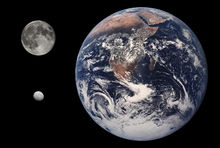
- Gauss calculated the elements of the planet Ceres and his analysis proved him to be the first of theoretical astronomers no less than the greatest of 'arithmeticians.' - W. W. Rouse Ball.]]
- W. W. Rouse Ball in: Robert Édouard Moritz Mathematica: The Philomath's Quotation Book, Mathematical Association of America, 1942, p. 157
- The only truly alien planet is Earth.
- J. G. Ballard in: Michael Seeds, Dana Backman Foundations of Astronomy, Cengage Learning, 1 January 2012, p. 472
- The fact that this chain of life existed [at volcanic vents on the seafloor] in the black cold of the deep sea and was utterly independent of sunlight—previously thought to be the font of all Earth's life—has startling ramifications. If life could flourish there, nurtured by a complex chemical process based on geothermal heat, then life could exist under similar conditions on planets far removed from the nurturing light of our parent star, the Sun.
- Robert Ballard in: Peter D. Ward, Donald Brownlee Rare Earth: Why Complex Life is Uncommon in the Universe, Springer Science & Business Media, 10 December 2003, p. 1
- There is nothing more mysterious than a TV set left on in an empty room. It is even stranger than a man talking to himself or a woman standing dreaming at her stove. It is as if another planet is communicating with you.
- Jean Baudrillard in: America, Verso, 1989, p. 50
- Copernicus, who rightly did condemn
This oldest system, form'd a wiser scheme;
In which he leaves the Sun at Rest, and rolls
The orb terrestrial on its proper poles;
Which makes the night and day by this career,
And by its slow and crooked course the year.
The famous Dane, who oft the modern guides,
To earth and sun their Provinces divides:
The earth's rotation makes the night and day,
The sun revolving through th'eccliptic way
Effects the various seasons of the year,
Which in their turn for happy ends appear.
This scheme or that, which pleases best, embrace,
Still we the fountain of their motion trace.
Kepler asserts these wonders may be done
By the magnetic vertue of the sun,
Which he, to gain his end, thinks fit to place
Full in the center of that mighty space,
Which does the spheres, where planets roll, include,
And leaves him with attractive force endu'd.
The sun, thus seated, by mechanic laws,
The earth, and every distant planet draws;
By which attraction all the planets found
Within his reach, are turn'd in ether round.
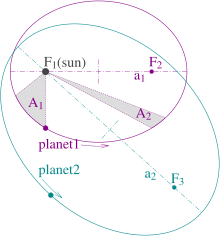
- Discovery always carries an honorific connotation. It is the stamp of approval on a finding of lasting value. Many laws and theories have come and gone in the history of science, but they are not spoken of as discoveries. Kepler is said to have discovered the laws of planetary motion named after him, but no the many other 'laws' which he formulated. … Theories are especially precarious, as this century profoundly testifies. World views can and do often change. Despite these difficulties, it is still true that to count as a discovery a finding must be of at least relatively permanent value, as shown by its inclusion in the generally accepted body of scientific knowledge.
- Richard J. Blackwell in “Discovery in Physical Sciences” pp.52-53 quoted in : Rodney Carlisle, Scientific American Inventions and Discoveries, John Wiley & Sons, 28 January 2005, p. 179
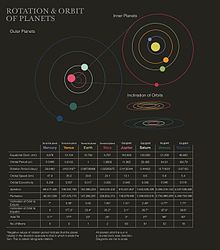
- There was yet another disadvantage attaching to the whole of Newton’s physical inquiries, … the want of an appropriate notation for expressing the conditions of a dynamical problem, and the general principles by which its solution must be obtained. By the labours of LaGrange, the motions of a disturbed planet are reduced with all their complication and variety to a purely mathematical question. It then ceases to be a physical problem; the disturbed and disturbing planet are alike vanished: the ideas of time and force are at an end; the very elements of the orbit have disappeared, or only exist as arbitrary characters in a mathematical formula.
- George Boole in: Artificial Intelligence and Symbolic Computation: International Conference AISC 2000 Madrid, Spain, July 17-19, 2000. Revised Papers, Springer Science & Business Media, 25 April 2001, p. 3
- That the machine of Heaven is not a hard and impervious body full of various real spheres, as up to now has been believed by most people. It will be proved that it extends everywhere, most fluid and simple, and nowhere presents obstacles as was formerly held, the circuits of the Planets being wholly free and without the labour and whirling round of any real spheres at all, being divinely governed under a given law.
- Tycho Brahe in: Marie Boas Hall The Scientific Renaissance 1450-1630, Courier Dover Publications, 2 April 2013, p. 117
- There really are not any spheres in the heavens … Those which have been devised by the experts to save the appearances exist only in the imagination, for the purpose of enabling the mind to conceive the otion which the heavenly bodies trace in their course and, by the aid of geometry, to determine the motion numerically through the use of arithmetic.
- Tycho Brahe in: John Freely Before Galileo: The Birth of Modern Science in Medieval Europe, Penguin, 27 August 2013, p. 145
- I would like to start by emphasizing the importance of surfaces. It is at a surface where many of our most interesting and useful phenomena occur. We live for example on the surface of a planet. It is at a surface where the catalysis of chemical reactions occur. It is essentially at a surface of a plant that sunlight is converted to a sugar. In electronics, most if not all active circuit elements involve non-equilibrium phenomena occurring at surfaces. Much of biology is concerned with reactions at a surface.
- Walter Houser Brattain in: Nobelstiftelsen Physics: 1942-1962, Nobel Foundation
- In space there are countless constellations, suns and planets; we see only the suns because they give light; the planets remain invisible, for they are small and dark. There are also numberless earths circling around their suns, no worse and no less than this globe of ours. For no reasonable mind can assume that heavenly bodies that may be far more magnificent than ours would not bear upon them creatures similar or even superior to those upon our human earth.
- Giordano Bruno in: Martin J. Rees Just Six Numbers: The Deep Forces that Shape the Universe, Basic Books, 2000, p. 22
- The Builder of this Universe was wise,
He plann’d all souls, all systems, planets, particles:
The Plan He shap'd all Worlds and Æons by,
Was—Heavens!—was thy small Nine-and-thirty Articles!- Thomas Carlyl in: Past and Present, Tredition, 6 February 2012, p. 175
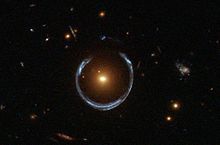
- Most known extrasolar planets (exoplanets) have been discovered using the radial velocity1, or transit methods. Both are biased towards planets that are relatively close to their parent stars, and studies find that around 17–30% of solar-like stars host a planet. Gravitational microlensing, on the other hand, probes planets that are further away from their stars. Recently, a population of planets that are unbound or very far from their stars was discovered by microlensing. These planets are at least as numerous as the stars in the Milky Way.
- A. Cassan, et al., in: One or more bound planets per Milky Way star from microlensing observations, Nature, International Journal of Science

- We only have to look around us to see how complexity … and psychic “temperature” are still rising: and rising no longer on the scale of the individual but now on that of the planet. This indication is so familiar to us that we cannot but recognize the objective, experiential, reality of a directionally controlled transformation of the Noosphere “as a whole.”
- Pierre Teilhard de Chardin in: Heart Of Matter, Houghton Mifflin Harcourt, 23 July 1980, p. 38
- How inappropriate to call this planet Earth when it is quite clearly Ocean.
- Arthur C. Clarke in: Christian Nellemann, Emily Corcoran Blue Carbon: The Role of Healthy Oceans in Binding Carbon : a Rapid Response Assessment, UNEP/Earthprint, 2009, p. 23

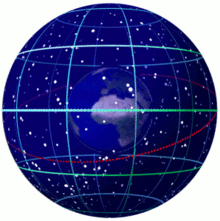
There is no one center of all the celestial circles or spheres.
The center of the earth is not the center of the universe, but only of gravity and of the lunar sphere
All the spheres revolve about the sun as their mid-point, and therefore the sun is the center of the universe....- Nicolaus Copernicus.
- After I had addressed myself to this very difficult and almost insoluble problem [circles of celestial sphere], the suggestion at length came to me how it could be solved with fewer and much simpler constructions than were formally used, if some assumptions (which are called axioms) [seven] were granted me. They follow in this order.
There is no one center of all the celestial circles or spheres.
The center of the earth is not the center of the universe, but only of gravity and of the lunar sphere.
All the spheres revolve about the sun as their mid-point, and therefore the sun is the center of the universe.
The ratio of the earth's distance from the sun to the height of the firmament is so much smaller than the ratio of the earth's radius to its distance from the sun that the distance from the earth to the sun is imperceptible in comparison with the height of the firmament.
Whatever motion appears in the firmament arises not from any motion of the firmament, but from the earth's motion. The earth together with its circumjacent elements performs a complete rotation on its fixed poles in a daily motion, while the firmament and highest heaven abide unchanged.
What appears to us as motions of the sun arise not from its motion but from the motion of the earth and our sphere, with which we revolve about the sun like any other planet. The earth has, then, more than one motion.
The apparent retrograde and direct motion of the planets arises not from their motion but from the earth's. The motion of the earth alone, therefore, suffices to explain so many apparent inequalities in the heavens.- Nicolaus Copernicus in: Franklin Le Van Baumer Main Currents of Western Thought: Readings in Western European Intellectual History from the Middle Ages to the Present, Yale University Press, 1978, p. 272
- It’s so hard to balance in our minds the knowledge that ‘the world’ is mundanely ‘a planet.’ The former is so holy; the latter merely a science project.
- Douglas Coupland in: Hey Nostradamus! , Bloomsbury Publishing USA, 2 December 2008, p. 208

- After a duration of a thousand years, the power of astrology broke down when, with Copernicus, Kepler, and Galileo, the progress of astronomy overthrew the false hypothesis upon which the entire structure rested, namely the geocentric system of the universe. The fact that the earth revolves in [[space] intervened to upset the complicated play of planetary influences, and the silent stars, related to the unfathomable depths of the sky, no longer made their prophetic voices audible to mankind. Celestial mechanics and spectrum analysis finally robbed them of their mysterious prestige. Thenceforth in that learned system of divination, which professed to discover from the stars the secret of our destiny, men saw nothing but the most monstrous of all the chimeras begotten of superstition.
- Franz Cumo in: Franz Valery, Marie Cumont Astrology and Religion Among the Greeks and Romans, G.P. Putnam, 1912, p. 16
- We will look upon the earth and her sister planets as being with us, not for us.
- Mary Daly in: Beyond God the Father: Toward a Philosophy of Women's Liberation, Beacon Press, 1985, p. 178
- The mass starts into a million suns;
Earths round each sun with quick explosions burst,
And second planets issue from the first.- Erasmus Darwin in: John Carey Eyewitness to Science, Harvard University Press, 1995,
- The first concept of a 'big bang' theory of the universe.

- A "planet" is defined a celestial body that (a) is in orbit around the Sun, (b) has sufficient mass for its self-gravity to overcome rigid body forces so that it assumes a hydrostatic equilibrium (nearly round) shape, and (c) has cleared the neighbourhood around its orbit.
- Definition by International Astronomical Union (IAU) in: iau0603 — News Release, International Astronomical Union, 2006
- The Solar System consists of eight "planets" Mercury, Venus, Earth, Mars, Jupiter, Saturn, Uranus and Neptune. A new distinct class of objects called "dwarf planets" exist. "Planets" and "dwarf planets" are two distinct classes of objects. The first members of the "dwarf planet" category are Ceres, Pluto and 2003 UB313 (temporary name).
- Definition by International Astronomical Union (IAU) in: "News Release"
- The "dwarf planet" Pluto is recognised as an important proto-type of a new class of trans-Neptunian objects.
- Definition by International Astronomical Union (IAU) in: "News Release"
- In 1684 Dr Halley came to visit him at Cambridge, after they had been some time together, the Dr asked him what he thought the Curve would be that would be described by the Planets supposing the force of attraction towards the Sun to be reciprocal to the square of their distance from it. Sir Isaac replied immediately that it would be an Ellipsis, the Doctor struck with joy & amazement asked him how he knew it, why saith he I have calculated it, whereupon Dr Halley asked him for his calculation without any farther delay. Sr Isaac looked among his papers but could not find it, but he promised him to renew it, & then to send it him.
- Abraham DeMoivre in: Richard S. Westfall Never at Rest: A Biography of Isaac Newton, Cambridge University Press, Apr 29, 1983, p. 403

- The word planet comes from the Greek for “wanderer,” because the planets' positions change relative to those of the stars. The eight (formerly nine) recognized planets that orbit the Sun are, in order of increasing distance, Mercury, Venus, Earth, Mars, Jupiter, Saturn,Uranus, and Neptune. The first four are called terrestrial planets and the next four giant, or Jovian, planets.
- Merriam Webster Dictionary in: planet, merriam-webster.com
- The terrestrial planets (of which Earth is the largest) are rocky with comparatively thin or negligible atmospheres. The Sun's heat is thought to have prevented the abundant volatile substances in the solar nebula from condensing in them as they formed. The giant planets formed farther out, where the gases were cool enough to condense, so the planets grew very massive and accumulated huge atmospheres of light gases, mainly hydrogen and helium. None of the giant planets has an accessible surface; their gaseous atmospheres gradually merge with their liquid interiors.
- Merriam Webster Dictionary in: "planet"
- Pluto, although it was recognized as a planet for decades, is distinct from either group, being much smaller than any of the eight planets and resembling a giant comet nucleus.
- Merriam Webster Dictionary in: "planet"
- In 2006 the International Astronomical Union demoted Pluto to the category of dwarf planet, which reflected astronomers' conclusion that it is a very large member of the Kuiper belt. Additional bodies rivaling or exceeding Pluto in size (e.g.,Eris) exist in the outer region of the solar system. The term minor planet is sometimes used to refer to any of the asteroids that lie mostly between the terrestrial and the giant planets.
- Merriam Webster Dictionary in: "planet"
- In astrology great importance is placed on the planets' positions in the 12 constellations of the zodiac.
- Merriam Webster Dictionary in: "planet"
- The planet : the planet Earth—used in informal phrases to say that someone is not aware of what is really happening or has ideas that are not realistic or practical.
- Merriam Webster Dictionary in: "planet"
- From an entertainment point of view, the Solar System has been a bust. None of the planets turns out to have any real-estate potential, and most of them are probably even useless for filming Dune sequels.
- Barbara Ehrenreich in: Mother Jones Magazine Vol. 11, No. 4, June 1986, p. 29
- Astronomy is a cold, desert science, with all its pompous figures,—depends a little too much on the glass-grinder, too little on the mind. 'T is of no use to show us more planets and systems. We know already what matter is, and more or less of it does not signify.
- Ralph Waldo Emerson in: The Complete Works of Ralph Waldo Emerson: Natural history of intellect, and other papers , Houghton Mifflin, 1904, p. 166
- The lessons of science should be experimental also. The sight of a planet through a telescope is worth all the course on astronomy; the shock of the electric spark in the elbow out values all theories; the taste of the nitrous oxide, the firing of an artificial volcano, are better than volumes of chemistry.
- Ralph Waldo Emerson in: Christopher J. Windolph Emerson's Nonlinear Nature, University of Missouri Press, 29 June 2007, p. 59

- Here lies Sir Isaac Newton, Knight, who by a vigour of mind almost supernatural, first demonstrated, the motions and Figures of the Planets, the Paths of the comets, and the Tides of the Oceans... Let Mortals rejoice that there has existed such and so great an ornament of Nature.
- Epitaph on tomb of Isaac Newton at Westminster Abbey (1727) in: Cheap Thoughts: Last Words and Epitaphs, Angelo State University
- There's almost no food that isn't genetically modified. Genetic modification is the basis of all evolution. Things change because our planet is subjected to a lot of radiation, which causes DNA damage, which gets repaired, but results in mutations, which create a ready mixture of plants that people can choose from to improve agriculture.
- Nina Fedoroff in: Claudia Dreifus An Advocate for Science Diplomacy, The New York Times, 18 August 2008
G - L
[edit]- It took less than an hour to make the atoms, a few hundred million years to make the stars and planets, but five billion years to make man!
- George Gamow in: The Creation of the Universe, Courier Dover Publications, 2 August 2012, p. 137
- Sir, The Planet [Neptune] whose position you marked out actually exists. On the day on which your letter reached me, I found a star of the eighth magnitude, which was not recorded in the excellent map designed by Dr. Bremiker, containing the twenty-first hour of the collection published by the Royal Academy of Berlin. The observation of the succeeding day showed it to be the Planet of which we were in quest.
- Johann Gottfried Galle in: Michael E. Bakich The Cambridge Planetary Handbook, Cambridge University Press, 2000, p. 282
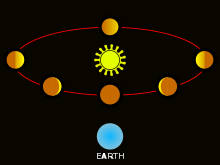
- But what exceeds all wonders, I have discovered four new planets and observed their proper and particular motions, different among themselves and from the motions of all the other stars; and these new planets move about another very large star [Jupiter] like Venus and Mercury, and perchance the other known planets, move about the Sun. As soon as this tract, which I shall send to all the philosophers and mathematicians as an announcement, is finished, I shall send a copy to the Most Serene Grand Duke, together with an excellent spyglass, so that he can verify all these truths.
- Galileo Galilei in: Sidereus Nuncius, Or The Sidereal Messenger, University of Chicago Press, Apr 15, 1989, p. 18
- The sun, with all those planets revolving around it and dependent on it, can still ripen a bunch of grapes as if it had nothing else in the universe to do.
- Galileo Galilei in: Gregory Sams Sun of gOd: Discover the Self-Organizing Consciousness That Underlies Everything, Weiser Books, May 1, 2009, p. 78

- I had rather be Mercury, the smallest among seven [planets], revolving round the sun, than the first among five [moons] revolving round Saturn.
- Johann Wolfgang von Goethe in: Rev. James Wood Dictionary of Quotations from Ancient and Modern, English and Foreign Sources:, Warne, 1893, p. 166

- I did not want to be a tree, a flower or a wave. In a dancer's body, we as audience must see ourselves, not the imitated behavior of everyday actions, not the phenomenon of nature, not exotic creatures from another planet, but something of the miracle that is a human being.
- Martha Graham in: Walter Pape, Frederick Burwick Reflecting Senses: Perception and Appearance in Literature, Culture, and the Arts, Walter de Gruyter, 1995, p. 274
- We see it [the as-yet unseen, hypothetical new planet, Neptune] as Columbus saw America from the coast of Spain. Its movements have been felt, trembling along the far-reaching line of our analysis with a certainty hardly inferior to that of ocular demonstration.
- Sir William Herschel in: The Living Age ..., Volume 169, Littell, Son and Company, 1886

- I shall explain a System of the World differing in many particulars from any yet known, answering in all things to the common Rules of Mechanical Motions: This depends upon three Suppositions. First, That all Cœlestial Bodies whatsoever, have an attraction or gravitating power towards their own Centers, whereby they attract not only their own parts, and keep them from flying from them, as we may observe the Earth to do, but that they do also attract all the other Cœlestial bodies that are within the sphere of their activity; and consequently that not only the Sun and Moon have an influence upon the body and motion the Earth, and the Earth upon them, but that Mercury also Venus, Mars, Saturn and Jupiter by their attractive powers, have a considerable influence upon its motion in the same manner the corresponding attractive power of the Earth hath a considerable influence upon every one of their motions also. The second supposition is this, That all bodies whatsoever that are put into a direct and simple motion, will continue to move forward in a straight line, till they are by some other effectual powers deflected and bent into a Motion, describing a Circle, Ellipse, or some other more compounded Curve Line. The third supposition is: That these attractive powers are so much the more powerful in operating, by how much the nearer the body wrought upon is to their own Centers. Now what these several degrees are I have not yet experimentally verified; but it is a notion, which if fully prosecuted as it ought to be, will mightily assist the Astronomer to reduce all the Cœlestial Motions to a certain rule, which I doubt will never be done true without it. He that understands the nature of the Circular Pendulum and Circular Motion, will easily understand the whole ground of this Principle, and will know where to find direction in Nature for the true stating thereof. This I only hint at present to such as have ability and opportunity of prosecuting this Inquiry, and are not wanting of Industry for observing and calculating, wishing heartily such may be found, having myself many other things in hand which I would first complete and therefore cannot so well attend it. But this I durst promise the Undertaker, that he will find all the Great Motions of the World to be influenced by this Principle, and that the true understanding thereof will be the true perfection of Astronomy.
- Robert Hook in: Jean Baptiste Biot Life of Sir Isaac Newton [tr. by sir H.C. Elphinstone], 1829, p. 16
- A rock or stone is not a subject that, of itself, may interest a philosopher to study; but, when he comes to see the necessity of those hard bodies, in the constitution of this earth, or for the permanency of the land on which we dwell, and when he finds that there are means wisely provided for the renovation of this necessary decaying part, as well as that of every other, he then, with pleasure, contemplates this manifestation of design, and thus connects the mineral system of this earth with that by which the heavenly bodies are made to move perpetually in their orbits.
- James Hutton in: Theory of the Earth: With Proofs and Illustrations, Volume 2, Hafner Publishing Company, 1795, p. 276
- We have the satisfaction to find, that in nature there is wisdom, system and consistency. For having, in the natural history of this earth, seen a succession of worlds, we may from this conclude that, there is a system in nature; in like manner as, from seeing revolutions of the planets, it is concluded, that there is a system by which they are intended to continue those revolutions. But if the succession of worlds is established in the system of nature, it is vain to look for anything higher in the origin of the earth. The result, therefore, of our present enquiry is, that we find no vestige of a beginning,-no prospect of an end.
- James Hutton in: Stephen Toulmin The Discovery of Time, University of Chicago Press, 1965, p. 157
- The art itself cannot philosophise
While man does that, and sees, and keeps a wife
And flies, and talks, and is extremely wise...
Will our Philosophy to later Life
Seem but a crudeness of the planet's youth,
Our Wisdom but a parasite of Truth?- Sir Julian Huxley in: Michael Ruse Defining Darwin: Essays on the History and Philosophy of Evolutionary Biology, Prometheus Books, p. 125
- Damn the Solar System. Bad light; planets too distant; pestered with comets; feeble contrivance; could make a better myself.
- Lord Francis Jeffrey in: Alan L. Mackay A Dictionary of Scientific Quotations, CRC Press, 1 January 1991, p. 131

- Once I got into space, I was feeling very comfortable in the universe. I felt like I had a right to be anywhere in this universe, that I belonged here as much as any speck of stardust, any comet, any planet.
- Mae C. Jemison in: Then & Now: Dr. Mae Jemison, CNN, 19 June 2005
- I am sorry to say that there is too much point to the wisecrack that life is extinct on other planets because their scientists were more advanced than ours.
- John F. Kennedy in: Pratheek Praveen Kumar Inclusive Growth, PRATHEEK, p. 18
- In the final analysis, our most basic common link is that we all inhabit this small planet. We all breathe the same air. We all cherish our children's future. And we are all mortal.
- John F. Kennedy in: Lewis Copeland et al., The World's Great Speeches: Fourth Enlarged (1999) Edition, Courier Dover Publications, 24 April 2012, p. 745
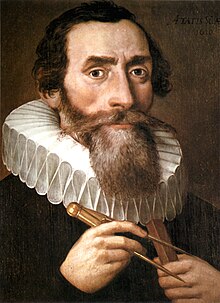
- And if you want the exact moment in time, it was conceived mentally on 8th March in this year one thousand six hundred and eighteen, but submitted to calculation in an unlucky way, and therefore rejected as false, and finally returning on the 15th of May and adopting a new line of attack, stormed the darkness of my mind. So strong was the support from the combination of my labour of seventeen years on the observations of Brahe and the present study, which conspired together, that at first I believed I was dreaming, and assuming my conclusion among my basic premises. But it is absolutely certain and exact that the proportion between the periodic times of any two planets is precisely the sesquialterate proportion of their mean distances.
- Johannes Kepler in: The Harmony of the World, Volume 209, American Philosophical Society, 1997, p. 411
- ...Pechblende does not belong either to the ores of zinc, or to those of iron, nor yet to the genus of tungsten or wolfram, and in general to none of the metallic substances hitherto known; but, on the contrary, that it consists of a peculiar, distinct, metallic substance. Therefore its former denominations, Pechblende, pitch-iron-ore, &c. are no longer applicable, and must be supplied by another more appropriate name. --- I have chosen that of Uranium, as a kind of memorial, that the chemical discovery of this new metal happened in the period of astronomical discovery of the new planet Uranus.
- Martin Heinrich Klaproth in Analytical Essays towards Promoting the Chemical Knowledge of Mineral Substances quoted in : A New Name for Pechblende, Massachusetts Institute of Technology
- Knox was engaged in a theological discussion with scientist John Scott Haldane. 'In a universe containing millions of planets,' reasoned Haldane, 'is it not inevitable that life should appear on at least one of them?'
'Sir,' replied Knox, 'if Scotland Yard found a body in your cabin trunk, would you tell them: 'There are millions of trunks in the world; surely one of them must contain a body? I think the would still want to know who put it there.'- Ronald Knox in: Clifton Fadiman The Little, Brown Book of Anecdotes, Little, Brown, 31 October 2009, p. 541
- The historian of science may be tempted to claim that when paradigms change, the world itself changes with them. Led by a new paradigm, scientists adopt new instruments and look in new places. even more important, during revolutions, scientists see new and different things when looking with familiar instruments in places they have looked before. It is rather as if the professional community had been suddenly transported to another planet where familiar objects are seen in a different light and are joined by unfamiliar ones as well.
- Thomas S. Kuhn in: Kathrin Glüer Donald Davidson: A Short Introduction, Oxford University Press, 5 December 2011, p. 213
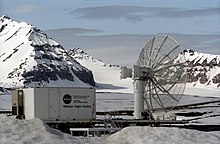
- Astronomy teaches the correct use of the sun and the planets. These may be put on a frame of little sticks and turned round. This causes the tides. Those at the ends of the sticks are enormously far away. From time to time a diligent searching of the sticks reveals new planets. The orbit of the planet is the distance the stick goes round in going round. Astronomy is intensely interesting; it should be done at night, in a high tower at Spitzbergen. This is to avoid the astronomy being interrupted. A really good astronomer can tell when a comet is coming too near him by the warning buzz of the revolving sticks.
- Stephen Leacock in: Literary lapses, John Lane Co., 1918, p. 128
- After the planet becomes theirs, many millions of years will have to pass before a beetle particularly loved by God, at the end of its calculations will find written on a sheet of paper in letters of fire that energy is equal to the mass multiplied by the square of the velocity of light. The new kings of the world will live tranquilly for a long time, confining themselves to devouring each other and being parasites among each other on a cottage industry scale.
- Primo Levi in Other People’s Trades quoted in: Carl C. Gaither Gaither's Dictionary of Scientific Quotations, Springer Science & Business Media, 5 January 2012, p. 101
- I would rather be ashes than dust!
I would rather that my spark should burn out in a brilliant blaze than it should be stifled by dry-rot.
I would rather be a superb meteor, every atom of me in magnificent glow, than a sleepy and permanent planet.
The proper function of man is to live, not to exist.
I shall not waste my days in trying to prolong them.
I shall use my time.- Jack London in: The Call of the Wild, eBookEden.com, 1972, p. 18
M - R
[edit]
Mephastophilis: Nine: the seven planets, the firmament, and the empyreal heaven.
Faustus: But is there not coelum igneum, et crystallinum? … - Christopher Marlowe.
- Faustus: How many heavens or spheres are there?
Mephastophilis: Nine: the seven planets, the firmament, and the empyreal heaven.
Faustus: But is there not coelum igneum, et crystallinum?
Meph.: No Faustus, they be but fables.
Faustus: Resolve me then in this one question: Why are not conjunctions, oppositions, aspects, eclipses all at one time, but in some years we have more, in some less?
Meph.: Per inaequalem motum respectu totius.
Faustus: Well, I am answered. Now tell me who made the world.
Meph.: I will not.
Faustus: Sweet Mephastophilis, tell me.
Meph.: Move me not, Faustus.
Faustus: Villain, have I not bound thee to tell me any thing?
Meph.: Ay, that is not against our kingdom.
This is. Thou are damn'd, think thou of hell.
Faustus: Think, Faustus, upon God that made the world!
Meph.: Remember this.
Faustus: Ay, go, accursed spirit, to ugly hell!‘Tis thou has damned distressed Faustus’s soul. Is’t not too late.- Christopher Marlowe in: David Bevington, Eric Rasmussen Doctor Faustus, Manchester University Press, May 15, 1993, p. 226
- On a perfect planet such as might be acceptable to a physicist, one might predict that from its origin the diversity of life would grow exponentially until the carrying capacity, however defined, was reached. The fossil record on Earth, however, tells a very different story.
- Simon Conway Morris in: Peter D. Ward, Donald Brownlee Rare Earth: Why Complex Life is Uncommon in the Universe, Springer Science & Business Media,10 December 2003, p. 83

- For nature is a perpetual circulatory worker, generating fluids out of solids, and solids out of fluids, fixed things out of volatile, & volatile out of fixed, subtle out of gross, & gross out of subtle, Some things to ascend & make the upper terrestrial juices, rivers and the atmosphere; & by consequence others to descend for a requital to the former. And as the earth, so perhaps may the sun imbibe this spirit copiously to conserve his shining, & keep the Planets from receding further from him. And they that will, may also suppose, that this spirit affords or carries with it thither the solary fuel & material principle of light; And that the vast aethereal spaces between us, & the stars are for a sufficient repository for this food of the sun and planets.
- Sir Isaac Newton in: David Brewster Memoirs of the Life, Writings and Discoveries of Sir Isaac Newton, Volume 1, Constable, 1855, p. 394
- Thus far I have explained the phenomena of the heavens and of our sea by the force of gravity, but I have not yet assigned a cause to gravity. Indeed, this force arises from some cause that penetrates as far as the centers of the sun and planets without any diminution of its power to act, and that acts not in proportion to the quantity of the surfaces of the particles on which it acts (as mechanical causes are wont to do) but in proportion to the quantity of solid matter, and whose action is extended everywhere to immense distances, always decreasing as the squares of the distances.
- Sir Isaac Newton in: Hylarie Kochiras Force, Matter, and Metaphysics in Newton's Natural Philosophy, ProQuest, 2008, p. 85
- Seeing therefore the variety of Motion which we find in the World is always decreasing, there is a necessity of conserving and recruiting it by active Principles, such as are the cause of Gravity, by which Planets and Comets keep their Motions in their Orbs, and Bodies acquire great Motion in falling; and the cause of Fermentation, by which the Heart and Blood of Animals are kept in perpetual Motion and Heat; the inward Parts of the Earth are constantly warm'd, and in some places grow very hot; Bodies burn and shine, Mountains take fire, the Caverns of the Earth are blown up, and the Sun continues violently hot and lucid, and warms all things by his Light. For we meet with very little Motion in the World, besides what is owing to these active Principles. And it were not for these Principles the Bodies of the Earth, Planers, Comets, Sun, and all things in them would grow cold and freeze and become inactive masses; and all Putrefaction, Generation, Vegetation and Life would cease; and the Planets and Comets would not remain in their Orbs.
- Sir Isaac Newton in: Opticks: Or, A Treatise of the Reflections, Refractions, Inflections and Colours of Light., W. and J. Innys, printers to the Royal Society, at the Prince's-Arms in St. Paul's Church-Yard., 1718, p. 375
- That the squares of the periodic times are proportion to the cubes of the major-axes. These laws were discovered by Kepler from observations made on Mars and stated by analogy as general laws, which, although not rigidly true, are sufficiently near to the truth to have led to the discovery of the law of attraction of the bodies of the solar system. The deviation from complete accuracy is due to the facts, that the planets are not of inappreciable mass, that, in consequence, they disturb each other's orbits about the Sun, and, by their action on the Sun itself, cause the periodic time of each to be shorter than if the Sun were a fixed body, in the subduplicate ratio of the mass of the Sun to the sum of the masses of the Sun and Planet; these errors are appreciable although very small, since the mass of the largest of the planets, Jupiter, is less than 1/1000th of the Sun's mass.
- Sir Isaac Newton in: Newton's Principia, sect. i., ii., iii., [tr. with notes, also a collection of problems, by P. Frost], 1854, p. 208-09
- Klaatu: So long as you were limited to fighting among yourselves -- with your primitive tanks and planes -- we were unconcerned. But soon you will apply atomic energy to space ships -- and then you become a threat to the peace and security of other planets. That, of course, we cannot tolerate.
- The Day the Earth Stood Still (1951 film) Edmund H. North
- The path towards sustainable energy sources will be long and sometimes difficult. But America cannot resist this transition, we must lead it. We cannot cede to other nations the technology that will power new jobs and new industries, we must claim its promise. That’s how we will maintain our economic vitality and our national treasure—our forests and waterways, our crop lands and snow-capped peaks. That is how we will preserve our planet, commanded to our care by God. That’s what will lend meaning to the creed our fathers once declared.
- Barack Obama in: Historic Documents of 2013, CQ Press, 14 July 2014, p. 8

- Penguins are an indicator of the health of our watery planet, and if they are unable to survive, we had better take notice or we might find our own survival threatened.
- Roger Tory Peterson in: Martin Rees Penguins, Basic Books, 1 March 2009, p. 160
- The nervous system is the most complex and delicate instrument on our planet, by means of which relations, connections are established between the numerous parts of the organism, as well as between the organism, as a highly complex system, and the innumerable, external influences. If the closing and opening of electric current is now regarded as an ordinary technical device, why should there be any objection to the idea that the same principle acts in this wonderful instrument? On this basis the constant connection between the external agent and the response of the organism, which it evokes, can be rightly called an unconditioned reflex, and the temporary connection—a conditioned reflex.
- Ivan Petrovich Pavlov in: David L. Sills, Robert King Merton Social Science Quotations: Who Said What, When, and Where, Transaction Publishers, 2000, p. 183


1. The Fixed Stars.
2. Saturn.
3. Jupiter.
4. Mars.
5. Mercury.
6. Venus.
7. The Sun.
8. The Moon.
This order is as good as any other that can be framed under a geocentric hypothesis... - Plato.
- The Spirits survey the heavens and the earth and all the harmonious motions of the universe. They see the heavenly bodies set in revolving whorls, which, whorl within whorl, combine to form the Spinning-whorl on the Spindle of Necessity; and the Goddess holds the spindle on her knee, and spins the thread which the Fates wind, unwind and cut. The heavenly bodies, or the spheres or whorls in which they lie, are arranged one within another in the following order:
1. The Fixed Stars.
2. Saturn.
3. Jupiter.
4. Mars.
5. Mercury.
6. Venus.
7. The Sun.
8. The Moon.
This order is as good as any other that can be framed under a geocentric hypothesis- Plato in: The Observatory, Volume 27, Editors of the Observatory, 1904, p. 364
- As the whorls differ from one another in respect of “ breadth of rim”, the first and outermost whorl is that which has its circular rim the broadest, and the sixth whorl comes next to it in regard to breadth of rim; and, proceeding in order of breadth, the fourth whorl comes third, and the eighth fourth, and the seventh fifth, and the fifth sixth, and the third seventh, and the second eighth.' Thus we have now a new classification of the heavenly bodies, in the following sequence:
1. The Fixed Stars.
2. Venus.
3. Mars.
4. The Moon.
5. The Sun.
6. Mercury.
7. Jupiter.
8. Saturn.- Plato in: The Classical Review, Volume 24 Plato’s Theory of Planets, Editors of the Observatory, 1904, p. 137
- Oh! That the Chemist's magic art
Could crystallize this sacred treasure!...
That very law which moulds a tear,
And bids it trickle from its source;
That law preserves the earth a sphere,
And guides the planets in their course.- Samuel Rogers in: Samuel Austin Allibone Poetical Quotations from Chaucer to Tennyson: With Copious Indexes, J. B. Lippincott & Company, 1875, p. 549

- The Sun is no lonelier than its neighbors; indeed, it is a very common-place star,—dwarfish, though not minute,—like hundreds, nay thousands, of others. By accident the brighter component of Alpha Centauri (which is double) is almost the Sun's twin in brightness, mass, and size. Could this Earth be transported to its vicinity by some supernatural power, and set revolving about it, at a little less than a hundred million miles' distance, the star would heat and light the world just as the Sun does, and life and civilization might go on with no radical change. The Milky Way would girdle the heavens as before; some of our familiar constellations, such as Orion, would be little changed, though others would be greatly altered by the shifting of the nearer stars. An unfamiliar brilliant star, between Cassiopeia and Perseus would be—the Sun. Looking back at it with our telescopes, we could photograph its spectrum, observe its motion among the stars, and convince ourselves that it was the same old Sun; but what had happened to the rest of our planetary system we would not know.
- Henry Norris Russell in: The Solar System and Its Origin, MacMillan, 1935, p. 2
S - Z
[edit]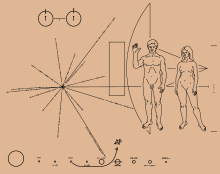

- If we lived on a planet where nothing ever changed, there would be little to do. There would be nothing to figure out. There would be no impetus for science. And if we lived in an unpredictable world, where things changed in random or very complex ways, we would not be able to figure things out. But we live in an in-between universe, where things change, but according to patterns, rules, or as we call them, laws of nature. If I throw a stick up in the air, it always falls down. If the sun sets in the west, it always rises again the next morning in the east. And so it becomes possible to figure things out. We can do science, and with it we can improve our lives.
- Carl Sagan in: Cosmos, Random House Publishing Group, 6 July 2011, p. 32
- The size and age of the Cosmos are beyond ordinary human understanding. Lost somewhere between immensity and eternity is our tiny planetary home.
- Carl Sagan in: Carl C. Gaither, Gaither's Dictionary of Scientific Quotations:, Springer Science & Business Media, 5 January 2012, p. 466

- Who are we? We find that we live on an insignificant planet of a humdrum star lost between two spiral arms in the outskirts of a galaxy, tucked away in some forgotten corner of a universe in which there are far more galaxies than people.
- Carl Sagan in: George L. Fouke Damn the Warocracy: A Plea to Restore American Democracy, Tree House Publishers, 2008, p. 366
- This is the excellent foppery of the world: that when we are sick in fortune—often the surfeits of our own behaviour—we make guilty of our disasters the sun, the moon, and stars, as if we were villains on necessity, fools by heavenly compulsion, knaves, thieves, and treachers by spherical predominance, drunkards, liars, and adulterers, by an enforced obedience of planetary influence, and all that we are evil in, by a divine thrusting on. An admirable evasion of whoremaster man, to lay his goatish disposition on the charge of a star! My father compounded with my mother under the Dragon's tail and my nativity was under Ursa Major, so that it follows that I am rough and lecherous. Fut! I should have been that I am had the maidenliest star in the firmament twinkled on my bastardizing.
- William Shakespeare in: The Tragedy of King Lear, Cambridge University Press, 11 August 2005, p. 121
- ...extending through all space, and compelling to their proper orbits, the planets, struggling fierce towards heaven's free wilderness.
- Percy Shelley in: Sir William Rowan Hamilton Introductory lecture on astronomy, delivered in Trinity college, Dublin, Nov. 8th, 1832, p. 6
- Astronomy may be revolutionized more than any other field of science by observations from above the atmosphere. Study of the planets, the Sun, the stars, and the rarified matter in space should all be profoundly influenced by measurements from balloons, rockets, probes and satellites....In a new adventure of discovery no one can foretell what will be found, and it is probably safe to predict that the most important new discovery that will be made with flying telescopes will be quite unexpected and unforeseen.
- Lyman Spitzer, Jr., in: Bulletin of the Atomic Scientists, Vol. 17, No. 5, Educational Foundation for Nuclear Science, Inc., May 1961, p. 191, 194
- If we imagine an observer to approach our planet from outer space, and, pushing aside the belts of red-brown clouds which obscure our atmosphere, to gaze for a whole day on the surface of the earth as it rotates beneath him, the feature, beyond all others most likely to arrest his attention would be the wedge-like outlines of the continents as they narrow away to the South.
- Eduard Suess in: The Face of the Earth: (Das Antlitz Der Erde), Clarendon Press, 1904, p. 1
- We are prone to forget that the planet may be measured by man, but not according to man.
- Eduard Suess in: Carl C. Gaither et al., Gaither's Dictionary of Scientific Quotations, Springer Science & Business Media, Jan 4, 2012, p. 1371
- This world was once a fluid haze of light,
Till toward the centre set the starry tides,
And eddied into suns, that wheeling cast
The planets: then the monster, then the man.- Lord Alfred Tennyson in: Huddersfield College Magazine, Volume 5 , Huddersfield College, 1879, p. 267
- ...the life of the planet began the long, slow process of modulating and regulating the physical conditions of the planet. The oxygen in today's atmosphere is almost entirely the result of photosynthetic living, which had its start with the appearance of blue-green algae among the microorganisms.
- Lewis Thomas in: Late Night Thoughts on Listening to Mahler's Ninth Symphony, Random House Publishing Group, 1 September 1984, p. 74
- I am entitled to say, if I like, that awareness exists in all the individual creatures on the planet—worms, sea urchins, gnats, whales, subhuman primates, superprimate humans, the lot. I can say this because we do not know what we are talking about: consciousness is so much a total mystery for our own species that we cannot begin to guess about its existence in others.
- Lewis Thomas in: A Long Line of Cells Collected Essays, 1990, p. 355
- From the rocket we can see the huge sphere of the planet in one or another phase of the Moon. We can see how the sphere rotates, and how within a few hours it shows all its sides successively … and we shall observe various points on the surface of the Earth for several minutes and from different sides very closely. This picture is so majestic, attractive and infinitely varied that I wish with all my soul that you and I could see it.
- Konstantin Eduardovich Tsiolkovsky (1911)in: William E. Burrows The Survival Imperative: Using Space to Protect Earth, Macmillan, 10 July 2007, p. 147

- This success permits us to hope that after thirty or forty years of observation on the new Planet [Neptune], we may employ it, in its turn, for the discovery of the one following it in its order of distances from the Sun. Thus, at least, we should unhappily soon fall among bodies invisible by reason of their immense distance, but whose orbits might yet be traced in a succession of ages, with the greatest exactness, by the theory of Secular Inequalities.
- Urbain-Jean-Joseph Le Verrier in: John Pringle Nicho The planet Neptune: an exposition and history, 1848, p. 90
- After the success of the confirmation of the existence of the planet Neptune, he considered the possibility of the discovery of a yet further planet.
- I tell my students, with a feeling of pride that I hope they will share, that the carbon, nitrogen, and oxygen that make up ninety-nine per cent of our living substance were cooked in the deep interiors of earlier generations of dying stars. Gathered up from the ends of the universe, over billions of years, eventually they came to form, in part, the substance of our sun, its planets, and ourselves. Three billion years ago, life arose upon the earth. It is the only life in the solar system.
- George Wald in: Louis C. Reichman, Barry J. Wishart American politics and its interpreters, W. C. Brown Co., 1971, p. 80
- Scientists themselves readily admit that they do not fully understand the consequences of our many-faceted assault upon the interwoven fabric of atmosphere, water, land and life in all its biological diversity. But things could also turn out to be worse than the current scientific best guess. In military affairs, policy has long been based on the dictum that we should be prepared for the worst case. Why should it be so different when the security is that of the planet and our long-term future?
- Charles, Prince of Wales in: Martin Rees Our Final Hour: A Scientist's Warning, Basic Books, 1 March 2009, p. 113

- Scientists still do not appear to understand sufficiently that all earth sciences must contribute evidence toward unveiling the state of our planet in earlier times, and that the truth of the matter can only be reached by combing all this evidence.... It is only by combing the information furnished by all the earth sciences that we can hope to determine 'truth' here, that is to say, to find the picture that sets out all the known facts in the best arrangement and that therefore has the highest degree of probability. Further, we have to be prepared always for the possibility that each new discovery, no matter what science furnishes it, may modify the conclusions we draw.
- Alfred Wegener in: Alan J. Scott Addicted to Placebos: Understanding Science and Society, Alan Scott, 2006, p. 114
- One of the grandest generalizations formulated by modern biological science is that of the continuity of life; the protoplasmic activity within each living body now on earth has continued without cessation from the remote beginnings of life on our planet, and from that period until the present no single organism has ever arisen save in the form of a bit of living protoplasm detached from a pre-existing portion; the eternal flame of life once kindled upon this earth has passed from organism to organism, and is still, going on existing and propagating, incarnated within the myriad animal and plant forms of everyday life.
- Harris Hawthorne Wilder in: History of the human body, H. Holt and company, 1909, p. 1
- A time will come when men will stretch out their eyes. They should see planets like our Earth.
- Sir Christopher Wren in: Stephen Webb If the Universe Is Teeming with Aliens … WHERE IS EVERYBODY?, Springer Science & Business Media, Oct 4, 2002, p. 150
Anonymous
[edit]- Dilbert: And we know mass creates gravity because more dense planets have more gravity.
Dogbert: How do we know which planets are more dense?
Dilbert: They have more gravity.
Dogbert: That's circular reasoning.
Dilbert: I prefer to think of it as having no loose ends.- Anonymous in: Classical Field Theory, The Mysearch Website

